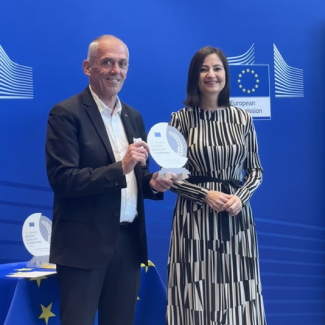
Australia: the CNRS opens its tenth office abroad
The CNRS has established a new office in Australia, which is home to extensive scientific collaboration, and is an important actor in major subjects such as polar research, corals, and radio astronomy. Office director Jean-Paul Toutain sets out its ambitions.
Why did the CNRS choose to open its office in Melbourne?
Jean-Paul Toutain1 : Since 2019, ASEAN2 and Oceania have been under the remit of the CNRS Office in Singapore, which I directed from 2019 to late 2021. A close look at the primary indicators for partnership intensity showed that Oceania—Australia and New Zealand in particular—represented approximately 60% of the area’s overall activity in terms of co-publications, research trips, and structural initiatives. The French scientific community’s interest in this region, which is of major importance for France as part of its Indo-Pacific strategy, was clearly demonstrated. This period saw the launch of the first International Research Laboratory3 (IRL) in Australia entitled CROSSING—on human-machine interactions and artificial intelligence, based in Adelaide—and the launch of the CNRS@CREATE subsidiary in Singapore, led by Dominique Baillargeat4 . As this two-pronged presence (office and subsidiary) in Singapore became difficult for our partners to understand, we developed the project to divide the ASEAN-Oceania area, and to establish a dedicated office for our relations with countries in Oceania. The Singapore office, which is henceforth in charge of ASEAN and the CNRS@CREATE subsidiary, is led by Dominique Baillargeat, and we opened a CNRS office in Melbourne with responsibility for the Oceania area, with me as the head. This is the tenth CNRS office, after the one opened in Ottawa, Canada.
Who are the CNRS’s partners there?
J-P. T. : The opening of the Melbourne office was strongly encouraged and supported by Invest Victoria and the Department of Treasury and Finance of the State of Victoria, which provided a subsidy to establish the office, and the University of Melbourne, which hosts the office.
More broadly, our scientific partners include most Australian universities and some Australian research centres. We have developed partnerships with the entire Group of Eight5 (Go8) of Australian research-intensive universities. For example, we initiated Joint PhD Programs6 with the Australian National University in Canberra and the University of Melbourne. A second class of candidates is currently being selected with the latter university. Finally, another leading CNRS endeavour in Australia has been the launch of the CROSSING IRL, in partnership with the three universities located in Adelaide (Universities of Adelaide, South Australia, and Flinders), IMT Atlantique, and Naval Group.
As with all CNRS offices abroad, relations with the French embassy in the country, and its Cooperation and Cultural Action Service (SCAC) in particular, is crucial. Interaction with the SCAC allows us to give greater consideration and emphasis to the diversity of French higher education institutions, as well as the complementarity of its actors with the CNRS.
What are the major scientific subjects being pursued by Australia, and more broadly by Oceania? How is the CNRS involved?
J-P. T. : The CNRS currently has one IRL, 12 IRPs7 , 5 IRNs8 , and 5 IEAs9 in the region, mostly in the fields of computer science, physics, the environment, health, ecology, HSS, biology, energy, Earth science, the climate, and astronomy.
In addition, extensive and long-term partnerships have emerged from CNRS structures in research focusing on the Southern Ocean and polar regions. We have very strong partnerships with the University of Tasmania, the Commonwealth Scientific and Industrial Research Organisation (CSIRO), and the Antarctic Division10 based in Hobart. This is where Astrolabe is based, the French patrol and logistical ship armed by the navy and made available to the French Polar Institute Paul-Émile Victor (IPEV), which takes oceanographic measurements and enables regular rotations with the Dumont D’Urville Antarctic Station. Finally, there is strong logistical cooperation between France and Australia, making it possible to pool together installations and transportation capacities in Antarctica.
Following French President Emmanuel Macron’s decision to make France a member of the Square Kilometre Array Observatory (SKAO)11 , radio astronomy became one of the fields with the greatest potential for developing partnerships with Australia, especially with respect to computing (for infrastructure), energy (with the use of hydrogen), and of course astronomy with the study of interstellar environments. A major cooperation effort between the CNRS and the ATOS company12 could play a central role in developing the SKAO’s computing capabilities. These possibilities are part of very long-term French-Australian collaboration in astronomy and instrumentation.
Finally, corals are also an area of importance. At the CNRS, the central actor is the Centre for Island Research and Environmental Observatory13 (CRIOBE), which since 2010 has managed the CORAIL Laboratory of Excellence that brings together 9 institutions and 4 overseas universities. It also hosts RéNSEE, one of the 5 stations in the INEE’s National Networks of Experimental Ecology Stations. CRIOBE has a close partnership with CSIRO and Curtin University (Perth, Australia).
How will the office support and encourage ties with French overseas laboratories? And more generally with the region, especially New Zealand?
J-P. T. : With regard to overseas, my role will primarily be to facilitate and foster ties between laboratories hosted by the two French universities in the Pacific—l’Université de Polynésie française and l’Université de Nouvelle-Calédonie—as well as to promote the Fonds Pacifique14 in partnership with the French embassy.
In New Zealand, the CNRS’s tools are fairly developed with 3 IRPs in the fields of physics and the adaptation of ecosystems to climate change. Since cooperation between Australian and New Zealand universities is very strong, it would be more interesting to develop cross-partnerships with Australia and New Zealand. The CNRS has cross-partnerships in Australia and New Zealand with the French territories of the Pacific. For instance, the VinAdapt IRP on agrosystems and climate change was selected for a project by the Pacific Fund, along with its New Zealand partner the University of Canterbury and the New Caledonian Agronomical Institute (IAC).
What are the office’s long-term objectives?
J-P. T. : The office will initially support the resumption of bilateral activity. The pandemic and the complete closure of Australia’s and New Zealand’s borders had highly negative effects on numerous partnerships. Structural tools that have evolved over time (IRP, IRN, IRL) fully played their role, preserving close ties even in the absence of mobility for the actors involved. However, the effect on new projects was more severe. The projects financed by IEAs in 2019 and 2020 had barely begun, and the pandemic clearly diminished researchers’ desire to propose new ones. With the opening of borders, we must re-establish a high level of exchange, and restart the machine in order to see new partnerships emerge.
The office’s role will also to support current tools that have proven their resilience, and that may be seeking to develop further. Efforts to strengthen the CROSSING IRL, a project that is now the most visible in Australia, should also be intensified. The office will naturally take an interest in any potential projects for opening new IRLs that would further establish the CNRS’s presence in Oceania. I should also mention support for the leading projects of the CNRS and other French higher education institutions in the region (Southern Ocean, polar, astronomy), projects involving laboratories from overseas territories, cross-partnerships with CNRS structures located in Singapore that enable exchanges between researchers and students, and finally support for projects in areas of obvious shared interest (the energy sector in general, and hydrogen in particular, artificial intelligence, engineering, environment and health).
- 1A volcanologist and fluid geochemist, Jean-Paul Toutain began his career at the Institut de Physique du Globe de Paris as the director of the Piton de la Fournaise Volcanological Observatory. At the Midi-Pyrénées Observatory, he conducted research on processes of volcanic degassing, and became involved in monitoring programmes. In 2008 he established the Explosive Volcanism Indonesia Instrumented Laboratory (VELI), which was certified by the INSU. He then served as the representative for the Research Institute for Development (IRD) and as the correspondent for the Toulouse University in Indonesia from 2010 to 2015, as the science and technology attaché at the French Embassy in South Africa through 2019, and from 2029 to 2021 as the director of the CNRS office for ASEAN and Oceania, based in Singapore.
- 2The Association of South Asian Nations (ASEAN) includes Indonesia, Malaysia, the Philippines, Singapore, Thailand, Brunei, Vietnam, Laos, Burma, and Cambodia.
- 3These cooperation tools structure the significant and enduring presence of scientists from a limited number of French and foreign research institutions (a single foreign partner) at a particular site.
- 4The director of the XLIM Laboratory (CNRS/Université de Limoges) from 2013 to 2019, and the Labex Sigma-Lim from 2014 to 2019, Dominique Baillargeat was named the Scientific Executive Director of CNRS@ CREATE in 2019.
- 5The Go8 includes the University of Melbourne, the Australian National University, the University of Sydney, the University of Queensland, the University of New South Wales, Monash University, the University of Western Australia, and the University of Adelaide.
- 6The objective of the Joint PhD Program is to have a French team and an international team work together on a joint project for research and doctoral training.
- 7These collaborative research projects between one or more CNRS laboratories and one or more foreign laboratories consolidate existing collaboration efforts.
- 8These cooperation tools structure an international scientific community consisting of one or more French laboratories—including at least one from the CNRS—and multiple foreign laboratories, in connection with a shared research topic or infrastructure.
- 9International Emerging Actions are projects co-led by a member of a CNRS unit and a member of a foreign research institution. Their purpose is to explore new research fields and partnerships on the international level.
- 10Department of the Australian Ministry of Agriculture, Water, and the Environment, tasked with managing Australia’s stations and territory in Antarctica and the Subantarctic.
- 11Project for giant radio telescope.
- 12Company specializing in digital transformation.
- 13CNRS/École pratiques des Hautes Etudes/Université de Perpignan.
- 14Created in 1985, the Economic, Social, and Cultural Cooperation Fund for the Pacific, known as the "Pacific Fund," is France’s primary cooperation instrument in the Pacific. Funded by the Ministry of Foreign Affairs, it contributes to the regional integration of New Caledonia, French Polynesia, and Wallis and Futuna islands.


